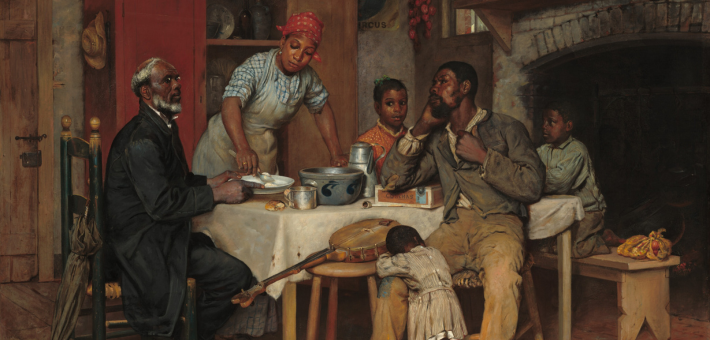Commentary on Genesis 22:1-14
Genesis 22:1-14 really stands out. It is a shocking story, showing God commanding the deadly sacrifice of Isaac. This story is also unique: it has no parallels in the Bible or ancient Near Eastern literature.
For Christian tradition, it is a central story foreshadowing Jesus’ crucifixion. In discussing Genesis 22, Hebrews 11:19 alludes to Christ “figuratively.” Isaac and Jesus were parallel sacrifices for early Christian writers, for example, Saint Augustine: “just as the Lord carried his cross, so Isaac himself carried to the place of sacrifice the wood on which he too was to be placed.”1 For Christians, the divine characterization of Isaac as “your only son … whom you love” (verse 2) resonates in the similar divine characterization of Jesus as “my beloved son” (for example, Matthew 3:17, Mark 1:11, and Luke 3:22; see also Hebrews 11:17).
Genesis 22 has been a central story also in Jewish tradition, which calls it “the binding of Isaac” (based on verse 9). A moving Jewish retelling characterizes Abraham and Isaac as “one to bind, the other to be bound.”2 The Qur’an (Surah 37:100-111) emphasizes the “virtuous” Abraham, also calling him “one of Our [God’s] faithful servants.”3
These religious traditions identify important elements in the story. But what did the story’s components evoke for audiences in ancient Israel? It was written at a time when child sacrifice was practiced (2 Kings 16:3, 21:6; see also Exodus 22:29). In particularly dire situations, the radical offering of a human rather than an animal might have seemed more capable of moving the god to help (for example, warfare in 2 Kings 3:27; see also warfare and plague reported among Phoenicians).4 But this is not the situation with Abraham. With child sacrifice lurking in the background, Genesis 22:1-14 is burdened with a terrifying inexplicability.
The story’s beginning, “God tested Abraham” (verse 1), serves to “explain” the story. This information is not told to Abraham, much less to Isaac, or even to Sarah (who is absent). The story’s characters don’t know God’s purposes. This “unknowing” compounds the specter of child sacrifice: Why does God command this? Is it really going to happen?
Abraham is to take Isaac “to the land of Moriah” where he is to “offer him there as a burnt offering on one of the mountains” (verse 2). The name of Moriah puns on two of the story’s verbs, “to see” (from the word-root *r’h in verses 4, 8, 13, 14 [2x], “provide” in New Revised Standard Version) and “to fear” (*yr’ in verse 12). The place is also called “the mount of the Lord” (verse 14). The only other biblical information about this place is “the house of the Lord in Jerusalem on Mount Moriah” in 2 Chronicles 3:1, a verse that seems to assume that Genesis 22 was a founding story for the Temple, itself located on God’s “holy mountain, beautiful in elevation … the joy of all the earth” (Psalm 48:2; see also Psalms 15:1, 24:3). Israelites would make joyful pilgrimage (Psalm 84:5-7) to Jerusalem: “I was glad when they said to me: ‘Let us go to the House of the Lord!’ Our feet are standing within your gates, O Jerusalem” (Psalm 122:1-2).
The Genesis narrative indicates that the journey takes three days (verse 4). The amount of time that it would take many Israelites to make the pilgrimage to Jerusalem to “celebrate a festival” (Exodus 5:1) involved “a three days’ journey” (Exodus 5:3; see also Numbers 10:33). To “celebrate festival” in Exodus 5:1 is related to the Hebrew noun ḥag and Arabic ḥajj, used for the Muslim pilgrimage to Mecca. The endpoint and highpoint of this joyful journey is the worship of God (see also Genesis 22:5) in the divine presence in the Temple, elsewhere characterized as “seeing God,” “seeing the face of God,” or the like (Psalms 11:7, 17:15, 27:4, 42:2, 63:2, and 84:7). These biblical parallels suggest that Genesis 22 presents the “test” of Abraham in terms of the three basic components of ancient pilgrimage: journey, sacrifice and vision of God.
The story also reverses these elements. Abraham and Isaac are accompanied by two servants, not the “multitude keeping festival” (Psalm 42:4); and Sarah is absent (see also Hannah’s pilgrimage in 1 Samuel 1-2). The journey is marked not by “glad shouts” (Psalm 42:4), but by spare conversation. The sacrifice at the Jerusalem Temple involves an animal, while the sacrifice here is Isaac, reversed only at the crucial moment with the divine provision of “a ram caught in a thicket” (verse 13). Overall, Genesis 22 is an electrifying “anti-pilgrimage,” grim not celebratory, terrifying not joyful. And yet: God speaks to Abraham at the journey’s beginning and at its end, but not in the meantime.
Sometimes it might seem God is asking us to enter situations, perhaps even new situations in life, which we think we are not ready for; do we go or not? The divine call may seem wrong. We may also expect God to be responsive to us on our journeys. What are we going to do, what is our journey, how is God with us?
Notes:
- Saint Augustine, Concerning the City of God against the Pagans, trans. Henry Bettenson, Penguin Classics (London/New York: Penguin, 2003), 694.
- The Book of Legends: Sefer Ha-Aggadah: Legends from the Talmud and Midrash, ed. H. N. Bialik and Y. H. Ravnitzky, trans. William G. Braude (New York: Schocken Books, 1992), 42-43.
- Gabriel Said Reynolds, The Qur’ān and the Bible: Text and Commentary, Qur’ān Translation by Ali Quli Qarai (New Haven/London: Yale University, 2018), 680-82.
- See Jon D. Levenson, The Death and Resurrection of the Beloved Son: The Transformation of Child Sacrifice in Judaism and Christianity (New Haven/London: Yale University, 1993). For this Phoenician practice as reported by Philo of Byblos, see Harold W. Attridge and Robert A. Oden, Jr., Philo of Byblos. The Phoenician History: Introduction, Critical Text, Translation, Notes, The Catholic Biblical Quarterly Monograph Series 9 (Washington, DC: The Catholic Biblical Association of America, 1981), 57 and 63.


July 2, 2023